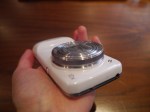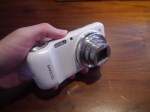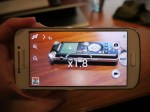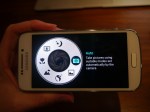Samsung’s Galaxy S4 Zoom steers its Galaxy brand into slightly new territory, by creating a hybrid smartphone-cum-pocket-camera. Unlike pretty much every other cameraphone around, the Zoom has a 10x optical zoom lens protruding from its rear.
In short, it’s a phone with two faces: one pure Galaxy smartphone, the second resembling a classic point-and-shoot camera. It’s a curious move that’s likely to grab consumers’ attention, but there’s a bigger question here — what’s it like using it?
If you only look at the Zoom’s phone half, you’d quickly discover it’s largely standard mid-range Galaxy fare — the usual TouchWiz interface runs atop Android 4.2.2 Jelly Bean, and there’s a dual-core 1.5GHz chipset powering the show. It felt fast and responsive during my brief hands on, and the 4.3-inch qHD AMOLED screen was bright and plenty big enough for all the typical smartphone uses, without being as huge a pane as Samsung’s flagship high-end smartphones.
The Zoom has a removable battery, accessible via a side door near the camera grip that also covers the SIM slot. Your usual selection of ports is accounted for too, though the microSD card slot, headphone jack, and micro-USB charger port are joined by a tripod mount on the base.
Samsung’s camera-centric chimera has a surprisingly pleasing feel, considering it’s considerably heavier than the company’s usual, plasticy smartphones. Despite the extra heft the overall feel is balanced. You won’t be putting it into the pocket of your skinny jeans as it would certainly drag you down, but the extra weight doesn’t feel too unwieldy. Perhaps because it looks so camera-like that the expectation is of more weight from the get-go.
The look of the device is exactly that of a hybrid. Holding it from the phone side it looks exactly like the Galaxy S4 Mini. Indeed, ignore the camera half and it is basically that phone, says Samsung. Turn it around and it’s a point and shoot digital camera. The only odd moments come when you’re holding it like a camera, so it’s in landscape orientation, but using the phone’s Android homescreen or menus. These stay in portrait orientation. Of course the camera app interface supports both landscape and portrait orientations, as do other apps – such as the web browser – but homescreens remain portrait-only.
Construction feels solid. There’s plenty of plastic on the device but the lens enclosure is metal. The edges of the phone also have the same brushed silver bands as the rest of the S4 range – albeit that appears to be plastic, rather than metal. The camera ergonomics work reasonably well, with a nicely shaped front ridge for gripping with your right hand. This is the same shiny plastic as the rest of the casing, so there’s no rubberised covering to aid grip.
The positioning of the phone power key (on the left of the top edge, when holding the phone in the camera stance) is potentially slightly awkward as it is close to where your left hand rests when you’re using the camera in landscape mode. There’s just about enough room to avoid it but a few accidental strikes are probably inevitable.
Now we’re getting to the fun part. The Galaxy Zoom has a 16MP sensor with optical image stabilisation, 10x optical zoom and a 24mm lens. Photo quality was difficult to assess in the relatively dingy conditions of the press room where the device was being demoed, and with limited hands-on time, but test shots did display a fair amount of noise. Exposure could also be uneven, and lower light shots came off with some noticeable blur, despite the image stabilisation tech inside the device.
Overall photo quality looked fair, but left plenty to be desired. Shooting in brighter outdoor conditions would undoubtedly result in crisper detail but as with many cameraphones the Galaxy Zoom appears to be a middling performer in less ideal lighting conditions (not that the average consumer will immediately realise that). The Zoom’s tactile optical zoom lens and physical camera looks are likely to win over a portion of Samsung’s target user based on their familiarity with the traditional camera form factor. Samsung cited “busy mums” as one target – i.e. people who take a lot of shots, and care about the results, but aren’t as discerning about image quality as camera pros.
Samsung has added an ‘expert’ mode to the Zoom’s camera interface for users who want to play around with a few more controls. This mode allows manual tweaking of setting like EV brightness, colour tone, saturation, sharpness, contrast, shutter speed, aperture, ISO, white balance and metering. However the typical Galaxy Zoom user is likely going to be sticking with its auto mode or consumer friendly ‘smart mode’ which offers a carousel of pre-sets to pick from, such as landscape, dawn, best face (which takes a series of shots and lets you pick the best one) and kids shot. The latter plays a baby-friendly noise to attract the subject’s attention so they’re looking at the camera before it snaps the shot. File that under ‘parent friendly’.
Likewise, the mechanical operation of the zoom lens is likely to take a little getting used to as it’s sited close to the edge of the device which means the lens can push against your fingers if you’re wrapping your hand around the back of the device, causing your grip to slip. It won’t take a user long to get accustomed to the moving protrusion, however. When you’re using the device as a phone, so when the lens is at its most retracted, it does stick out into your palm, feeling a bit lumpy. It’s not actually too bad though — and gives something grippy to tighten your palm around.
On the top right of the device, when holding the phone in the classic camera stance, is its round physical shutter key. This looks like a traditional camera shutter button. It requires a very light touch for the initial focus depression, and more of a squeeze to take the photo as you’d expect. The button felt nice and responsive during my hands on. It can also be used to jump right into camera mode from elsewhere in the OS by holding the button down.
When not in the camera application, turning the lens ring activates a camera shortcut menu where you can choose from a range of camera mode options – either by tapping the touchscreen or turning the dial to move the selection then hitting the shutter to select the mode you want. Modes are also accessible from within the camera app via a touch key at the right hand side of the interface.
When using the lens ring shortcut, modes on offer are night, animated photo, macro, landscape, beauty face (a mode that automatically ‘airbrushes’ portraits), the gallery and an auto mode that pre-selects the mode to take the shot in, based on what the camera calculates is the most appropriate mode for the conditions you’re shooting in.
The zoom ring can also be used to navigate inside the gallery, including to zoom into shots to look at details. The navigation doesn’t seem especially well thought through, however, as you can’t apparently move through photos in sequence. To browse shots you have to resort to using your finger on the screen. The fly-by-wire feel of the lens ring is also slightly too loose to be entirely pleasing. Plus there’s a slight lag between you turning and the camera interface responding by zooming in/out. It’s not a huge lag, but does make it feel slightly unresponsive.
Overall, the Galaxy S4 Zoom feels like a well thought through concept — the combining of the traditional camera form with a smartphone works surprisingly well and doesn’t feel unbalanced. But the let down is not that it looks too ugly or feels too heavy or is just weird to operate. Rather what’s a bit disappointing is that the picture quality isn’t better. For a mid range cameraphone the Galaxy S4 Zoom’s photos are probably about as good as you’d expect. But with such a whopping zoom lens on the back it’s hard not to hope for a little more photographic oomph. Still, this device’s mainstream consumer target may well be perfectly happy with what its lens can turn out — and zoom in on.






















